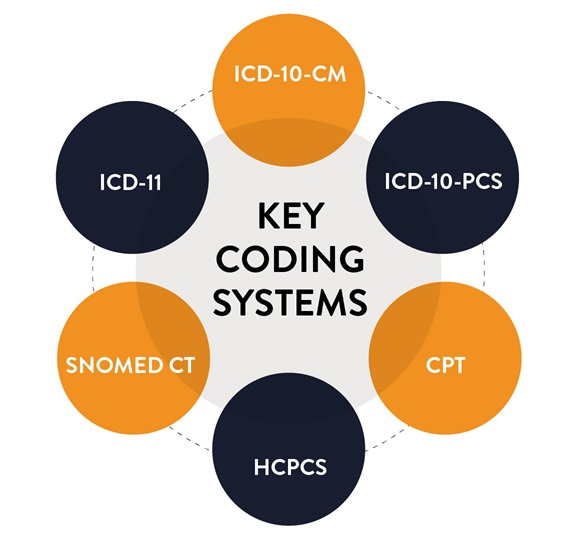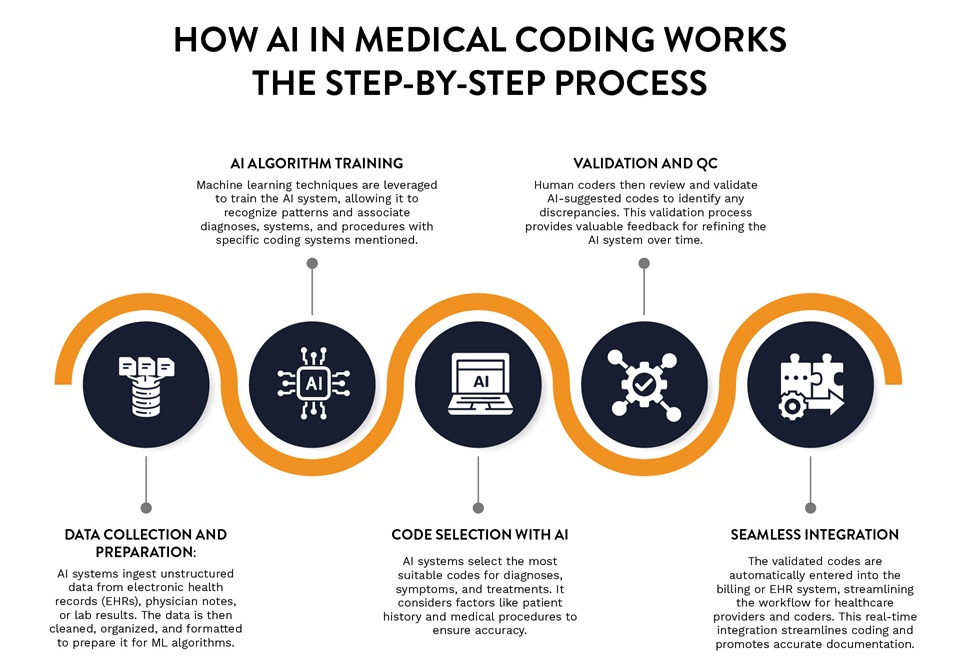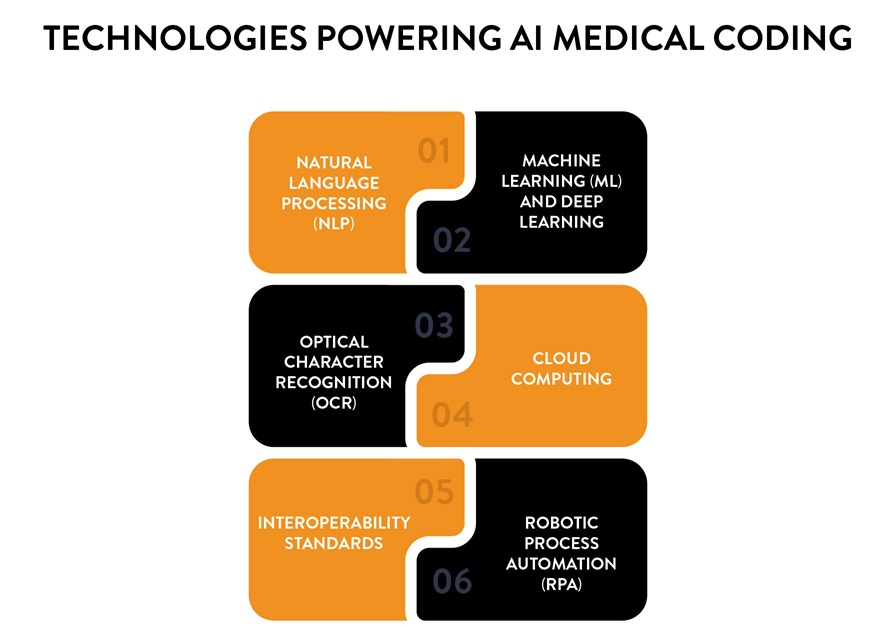If you’ve ever worked in healthcare, you know the grind of medical coding—hours spent deciphering notes, assigning codes, and double-checking compliance. It’s an essential task, but it’s also a bottleneck that slows down care and strains budgets.
In fact, according to a recent study by the American Medical Association (AMA), coding errors cost the healthcare industry approximately $36 billion annually in revenue leakage, denied claims, and potential fines.
Enter Artificial Intelligence (AI). It is proving to be a game-changer in 2025 by making coding faster, sharper, and more reliable. This isn’t just a tech trend; it’s a shift that’s helping healthcare providers get back to what they do best—provide the best possible care for their patients.
Whether you are a medical coder looking to stay ahead, an RCM leader trying to streamline operations, or a payer managing claims, this guide is for you. Let’s walk you through how AI is transforming medical coding and why it’s a must-have technology in 2025 and beyond.
What is Medical Coding?
Medical coding is the process of translating patient records into universally recognized alphanumeric codes. It serves as the foundation for healthcare finances, ensuring providers are reimbursed correctly for the services rendered.
What is AI in Medical Coding?
AI in medical coding uses natural language processing (NLP), machine learning (ML), and data analytics to automate the process of assigning accurate codes in a fraction of the time, compared to manual coding. It handles massive datasets with utmost ease, minimizing errors and boosting compliance.
Key Coding Systems

To break it down:
ICD-10-CM (International Classification of Diseases, 10th Edition, Clinical Modification)
It is a widely used medical coding system that classifies diseases and conditions. It consists of three to seven characters, including both letters and numbers.
ICD-10-PCS (International Classification of Diseases, 10th Edition, Procedure Coding System)
It is specifically designed for coding medical procedures and surgeries. Unlike ICD-10-CM, it employs a seven-character alphanumeric code structure.
CPT (Current Procedural Terminology)
They are maintained by the American Medical Association (AMA) and used to document medical procedures and services provided by healthcare professionals. CPT codes are categorised into three levels: procedures, services, and emerging technologies.
HCPCS (Healthcare Common Procedure Coding System)
It is primarily used for services that are not covered by CPT codes. It has two levels of codes: Level I (cover supplies, equipment, and other services) and Level II (essential for accurately documenting items such as durable medical equipment, prosthetics, orthotics, etc.)
SNOMED CT (Systematized Nomenclature of Medicine – Clinical Terms)
It is a clinically validated, semantically rich, multilingual, comprehensive clinical terminology that can be used to represent clinically relevant information consistently and reliably in an EHR.
ICD-11 ( International Classification of Diseases, 11th Revision)
It is the most recent version of the ICD and is used in over 100 countries around the world. ICD-11 is entirely digital, containing around 17,000 unique codes and over 120,000 codable terms.
A Quick Look Into Traditional Medical Coding
Coders review patient records, identify relevant diagnoses and procedures, assign codes, and prepare claims. If a claim gets rejected, they go back in to fix errors or handle audits. It’s a tedious process that is prone to human error and employee burnout.
Want to dive into the evolution of medical coding from traditional manual processes to AI-driven solutions? Check out this insightful blog.
How AI in Medical Coding Works – The Step-by-Step Process
AI in medical coding is like having your best coder code 24/7 at lightning speed, with almost 100% accuracy.

Here’s how it works:
- Data Collection and Preparation: AI systems ingest unstructured data from electronic health records (EHRs), physician notes, or lab results. The data is then cleaned, organized, and formatted to prepare it for ML algorithms.
- Al Algorithm Training: Machine learning techniques are leveraged to train the AI system, allowing it to recognize patterns and associate diagnoses, systems, and procedures with specific coding systems mentioned.
- Code Selection with AI: AI systems select the most suitable codes for diagnoses, symptoms, and treatments. It considers factors like patient history and medical procedures to ensure accuracy.
- Validation and QC: Human coders then review and validate AI-suggested codes to identify any discrepancies. This validation process provides valuable feedback for refining the AI system over time.
- Seamless Integration: The validated codes are automatically entered into the billing or EHR system, streamlining the workflow for healthcare providers and coders. This real-time integration streamlines coding and promotes accurate documentation.
Technologies Powering AI Medical Coding
AI medical coding relies on advanced technologies like:

- NLP: Reads and understands clinical notes like a human would.
- ML and Deep Learning: Trains models recognize patterns and assign codes. Deep learning enhances NLP for complex cases, like rare diseases.
- Optical Character Recognition (OCR): Converts scanned documents into digital text.
- Cloud Computing: Enables scalable, real-time processing.
- Interoperability Standards: Ensures compatibility with EHRs and other healthcare platforms.
- Robotic Process Automation (RPA): Automates repetitive tasks like data entry to save time and coder bandwidth.
Benefits of AI in Medical Coding
For healthcare providers, AI coding software automates repetitive tasks, saving time and reducing errors through natural language processing. This leads to faster claim submissions, improved cash flow, and lower labor costs. Medical coding AI tools ensure compliance with standards like ICD-11 and CPT, while handling large record volumes for scalability.
Payers benefit from AI in medical coding through accurate claims that speed up processing and reduce manual reviews. Medical coding AI flags fraudulent patterns, cuts administrative costs, and generates data for trend analysis, ensuring consistent reimbursements.
Patients experience quicker billing resolutions with fewer disputes, as medical coding AI tools ensure transparent, accurate bills. Reduced errors prevent claim denials, lowering unexpected costs, and AI medical coding software supports better care coordination.
For public health and research, medical coding AI produces reliable, standardized data for real-time insights and epidemiological studies. AI in medical coding accelerates research and supports global health monitoring by enabling data comparisons.
Challenges of AI Medical Coding
Despite its multifaceted benefits, AI medical coding struggles with these challenges:
- Risk of Data Inaccuracies: Medical coding AI tools, while efficient, can generate inaccurate codes due to incomplete or incorrect data. Regular audits and human oversight are of utmost importance for accuracy.
- Compliance Risk with Regulatory Standards: AI systems must be constantly updated to adhere to the constantly evolving regulatory standards to avoid legal issues and maintain patient trust.
- Over-reliance on AI: AI coding software requires minimal human oversight. This could lead to skill degradation among your in-house coders. The fix? Promote continuous training and skill development.
- Threat to Patient Privacy and Data Security: Handling patient data with AI raises concerns about privacy and data security. To overcome this challenge, healthcare providers should have robust security measures in place to safeguard sensitive data.
AI Medical Coding vs. Traditional Coding
Here are some key distinctions between traditional and AI medical coding that tell us why the steady move towards AI-driven tools is the only way we can increase accuracy and efficiency:
| Aspect | AI Medical Coding | Traditional Coding |
| Speed | Seconds per record | Minutes to hours per record |
| Accuracy | Over 90% accuracy with ongoing learning | 70-85% accuracy, with human errors |
| Scalability | Handles huge volumes of data easily | Limited by coder availability |
| Cost | Higher upfront, cheaper long-term | Ongoing labor expenses |
| Compliance | Built-in rule checks | Manual audits, higher risks |
Your Ultimate AI Medical Coding Solution
Owing to the transformative nature of the healthcare industry, several AI medical coding tools are currently leading the market. These tools automate the coding process and improve accuracy.
Enter Aidéo with its autonomous coding platform—Gemini™.
Aidéo is a leading provider of medical coding solutions. Our AI-powered coding platform, Gemini™, uses the power of NLP and ML to assign codes at lightning speed, taking the burden off human coders so that they can focus on more complex cases.
The result? Reduced turnaround time by more than 50% and improved coder efficiency by up to 65%!
Future Trends in AI Medical Coding
The current applications of AI in medical coding are just the tip of the iceberg. As algorithms become more sophisticated and are trained on more diverse data sets, the accuracy and efficiency will only keep skyrocketing.
Here’s what we can expect to see in the coming years:
- Improved Predictive Analytics: In the coming years, AI is set to provide even deeper insights into billing trends and denial patterns.
- Greater Integration: Seamless integration with EHRs and other healthcare systems will further streamline workflows.
- Personalized Denial Management Solutions: The integration of AI will allow healthcare providers to move away from the one-size-fits-all approach to a more personalized denial management strategy.
The Bottom Line
The AI revolution in medical coding is no longer a futuristic concept—it is here, and it is transforming the way healthcare organizations operate. According to Precedence Research, the global AI in medical coding market is projected to reach around USD 9.16 billion by 2034.
The next big question is, is your organization ready to be a part of this new wave?
Aidéo could be your ideal partner. Our coding platform, Gemini™, is a streamlined workflow tool that uses advanced AI and ML algorithms to continuously assemble, catalog, and codify certified coder expertise. Gemini™ analyzes patient information from EHR systems and physician notes to automatically suggest the most accurate code.
Additionally, an AAPC Evaluation and Management (E/M) Coding Calculator is embedded into the Gemini™ coder platform to assist in standardizing the coding of complex E/M medical claims. This integration provides Aideo’s customers access to the latest E/M codes, MDM definitions, time-based coding guidelines, shared or split services details, and more.
Ready to know how we can transform your coding operations? Connect with us today for a free demo!
FAQs:
Q1. How accurate is AI medical coding?
Answer: Accuracy in AI medical coding typically falls within the range of 90% to 98% in well-managed healthcare organizations.
Q2. Will AI replace medical coders?
Answer: AI is unlikely to fully replace human medical coders because even though AI can manage to do routine tasks on its own, human intervention is still required for complex cases.
Q3. Can AI handle specialty-specific coding?
Answer: Yes, AI can, in fact, handle specialty-specific medical coding. AI systems like Aidéo can be trained on large data sets that include diverse medical specialties, allowing them to comprehend and adapt to the specific requirements of each specialty.

